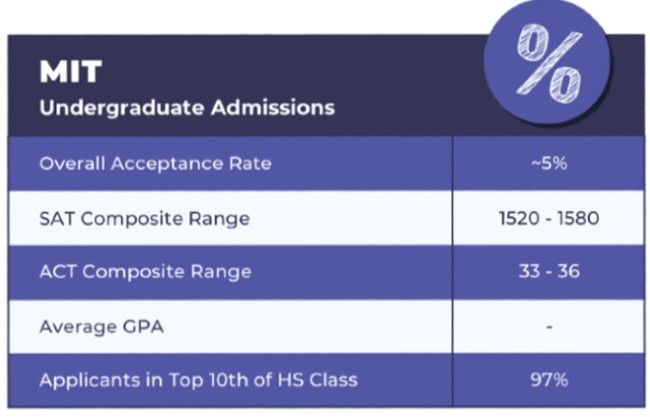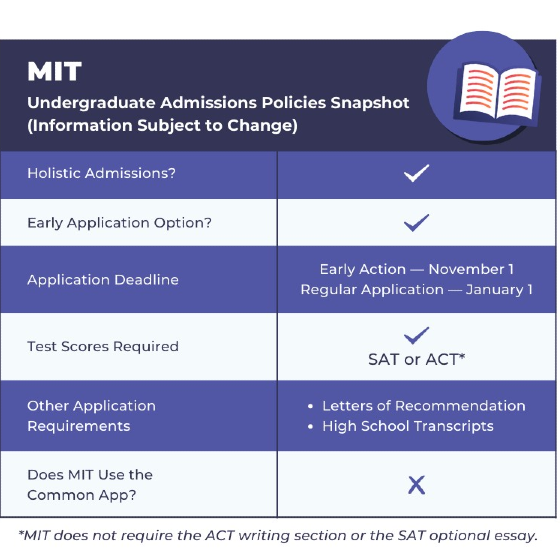A Guide to NESCAC Schools: Ranking, Acceptance Rates, and Comparison
Read now/f/64062/1920x800/bc44cd8917/williams-college.jpg)
Chat with us
/f/64062/1484x718/f91efcbd12/mit.JPG)
Jump To
How Hard Is It to Get Into MIT?
Getting Into MIT
What to Know Before Applying to MIT
Increasing Your Chances
Your Turn!
An MIT Success Story
Is MIT Right for You?
Getting into a top school like MIT is not easy. But, with the right insights and the right planning and preparation, you can definitely boost your chances for success.
We've helped over 6,000 students get into top colleges, and in this post we’ll put the spotlight on the Massachusetts Institute of Technology or MIT. You’ll discover how competitive MIT is, explore what MIT is looking for in students, and get valuable insights and tips for how to increase your chances for being a successful MIT applicant.
For the MIT class of 2027, almost 27,000 students applied and about 1,260 were accepted, meaning that even among other top schools, the admissions process at MIT is very competitive.
Put another way, applicants have a > 5% chance of admissions to MIT, so only 1 in every 20 applicants gets admitted to MIT!
This is why YOU need to understand what’s needed to be a highly competitive applicant…


So, how do you stand out when you apply to a school that can only admit about 5% of applicants each year?
Need to review some basics about college applications? Check out our brief overview: How to Apply for College…
A Day in the Life: MIT Student
Many students aspiring to attend a top university will want to know if their GPA, transcripts, and test scores are good enough. But, knowing the ethos of your top-choice university and understanding what kinds of students make a good fit is essential. Armed with these insights you’ll be better positioned to understand what qualities to develop and spotlight as an aspiring MIT student.
World-famous schools are typically proud to stand out for some unique mission and set of values or ideals.
In other words, just like famous people, famous schools also have personalities — that shape instruction, programs, and campus life. The school ethos also influences the kinds of students the school wants to recruit and admit.
Here is what MIT says about its mission, the qualities it looks for in applicants, and the school's core values:
“The mission of MIT is to advance knowledge and educate students in science, technology, and other areas of scholarship that will best serve the nation and the world in the 21st century.”
Is it really true that being “a good fit” matters a lot for admissions, even if you have really good grades and test scores?...
Well, here’s what MIT has to say:
“Ask any admissions officer at MIT, and they will tell you that while grades and scores are important, it’s really the match between applicant and the Institute that drives our selection process.”
| Use These Insights to Amplify your Applicant Profile for MIT |
|---|
| How will you develop and showcase qualities such as initiative, risk-taking, a collaborative spirit, creativity, and curiosity? |
| How will your personal essay and your participation in extracurriculars resonate with the values of MIT, the campus culture they are trying to foster, and the impact they want to make on the world? |
In this section we highlight some specific factors and policies guiding early and regular admissions, application processes, and the weight of different admissions considerations at MIT.

MIT has its own application forms and essay prompts. You can access these online from mid-August through January 1. Get more information about online applications at MIT.
| Overall | Early Round Applicants | Crimson Education Students |
|---|---|---|
| ~4.7% | ~5.7% | ~21% |
If your dream is to get into a highly selective school like MIT, you’ll want to know all the important facts about the school’s internal admissions guidelines and practices.
MIT uses a holistic approach to admissions — this means looking at your academics broadly while also considering other personal qualities.
Standardized tests are required for anyone applying as a first-year student to MIT. However, they are not the only factor, or even the most important factor. When we receive your application, we review all of your academic information—grades, scores, classes, etc. —to ensure that you are prepared for MIT.
What factors does MIT consider in addition to your grades?…
For its holistic approach, MIT takes into account many academic and non-academic factors and application components.
**Source: National Center for Education Statistics (NCES)
Because it’s so important to know what is considered for admissions, Crimson Advisors also look beyond the most well-known factors, including insights into how much importance admissions officers give to each different factor.
Here’s a more complete look at all the factors MIT says it considers and how MIT ranks them in terms of importance:
Source: MIT, Common Data Set 2022-23 (Class of 2027)
Check out this excerpt from our vast resource library: what MIT admissions officer Kim Lesly Hunter told us about holistic admissions at MIT!
MIT Admissions Workshop: Who Gets In? Behind the Scenes at MIT Admissions
“What MIT is Looking For in Applicants” (watch from 39:00 minute mark to 42:00 minute mark)
At Crimson we’d rarely suggest anyone focus on race or ethnic status when it comes to calculating your chances of getting into a top-choice school.
That said, top schools often want to foster a diverse learning environment on campus.
As you can see, for the MIT class of 2027, religious affiliation was not considered in admissions decisions, but race and ethnicity were considered for admissions.
And, while it’s hard to know what the future holds, it’s likely that race and ethnicity will have less importance for future applicants because of important new court rulings.
In terms of campus diversity at MIT, faculty are mostly White (58%), but the students are more diverse. About 75% of students are Non-white.
Source: College Score Board, US Department of Education (retrieved August 2023)
Although MIT tells students that the early application round doesn’t give you any admissions advantage, acceptance rates trend a bit higher for early applicants.
Application deadlines:
MIT Early Action isn’t single-choice, binding, or anything like that. If you choose to apply to MIT during Early Action, MIT does not place any limits on where else you may apply, and we do not require you to attend if admitted...
If you apply to another school during Early Action and that school does have a restriction, MIT requires that you follow those restrictions. So for example, if you apply to another school that is ‘single choice’ — meaning that you can only apply there during the early period — you may not simultaneously apply to MIT. And, if you’re admitted somewhere ‘binding,’ then even if we admit you, you must go there instead. So choose wisely!...
4 critical strategies for a more successful college journey
There are limited strings attached for applicants who submit their application in the early application cycle at MIT.
This means there’s not much to lose by applying early, and — in some years at least — the odds of admissions, statistically, slightly favor those who apply early.
One reason starting early can be so important, is the time it can take to prepare adequately for the SAT/ACT test. Since reporting SAT or ACT scores is required for your MIT application, you’ll want to prepare thoroughly and consider backup resources you may need for succeeding.
At top schools with so many academically qualified applicants, choosing the right extracurriculars will help you stand out. If you’re still in the early stages of your college journey, Crimson Education Advisors can provide personalized guidance and help you chart a path to MIT.
Once you know what kinds of extracurriculars will match your interests and resonate with MIT’s ethos, our Advisors can help you find high quality enrichment programs, or you can check out the summer programming search tools at SummerApply!
From developing professional and academic skills, to spotlighting your personal growth story beyond test scores and GPA, the right extracurriculars should help you boost your chances as an MIT applicant.
Standing out as an MIT applicant is doable and achievable, but with a long runway you’ll likely have better chances for success.
Be sure to start your college journey early, when you begin high school, or even earlier, in middle school.
You’ll need a long time runway in order to:
| What if I'm already approaching the end of high school...? |
|---|
| For insights into how you’ll stack up against other MIT applicants, try using the Crimson Education US College Admissions Calculator. For more nuanced feedback, talk to a Crimson Advisor. |
Crucial to making an effective roadmap for your college journey is knowing the destination. Setting goals is the first step. Having clear goals will set you up for the next step too — creating an action plan!
Consider the valuable insights we’ve shared as you set specific goals for your journey:
→ set high goals for SAT/ACT testing & for your GPA
→ pursue extracurriculars that develop and demonstrate the personal qualities MIT cares most about
→ plan ahead in order to be able to submit strong admissions essays and to have time to confer with teachers and counselors about letters of recommendation

Your goals and action plan go hand in hand.
With specific and targeted goals, you’ll see how easy it is to make action plans that motivate you on your college journey and dramatically improve your chances for success.
We’ve provided an action plan outline below to help you. But going it alone can feel overwhelming.
We encourage you to reach out to helpful and trusted adults for input and guidance: parents and guardians, academic counselors, and supportive peers… For a more comprehensive approach, our experienced Advisors can help you each step of the way and work with you to create an individualized action plan tailored to your target schools!
Helpful Resources
Crimson Education US College Planner — Unlock Crimson resources and advice, and get easy-to-use tools to track important deadlines. Whether in writing or using digital tools, you’ll want to track your progress!
The tables below have real data for MIT that will guide you in setting goals for your roadmap to MIT!
After setting a personalized goal for each factor, you’ll list some real action steps for meeting that goal…
| Admissions Data | Crimson Advisors Recommend... | Your Goal | |
|---|---|---|---|
| SAT Range | 1480 – 1580 EBRW 730 MATH 750 | Aim for a SAT score of 1500 and above | ? |
| ACT Range | 33 – 36 English 35 Math 32 | Aim for a ACT score of 34 and above | ? |
GOAL 1 ACTION STEPS:
To achieve this goal I will
Helpful Resources
SAT/ACT Practice Tests — quickly find which skills to review and get additional test practice
SAT/ACT Exams Tutoring — tap into a our network of exceptionally qualified tutors
US College Admissions Calculator — explore how your SAT/ACT scores correlate to prospective target schools
| Admissions Data | Crimson Advisors Recommend... | Your Goal |
|---|---|---|
| 4.2% average (73% of students had a GPA of at least 4.0)* *If you’re studying the IB, this translates to scoring mostly 7s and achieving a minimum score of at least 42 | 4.0 and above | ? |
GOAL 2 ACTION STEPS:
To achieve this goal I will
Helpful Resources
GPA Calculator — quickly calculate your unweighted and/or weighted GPA!
Online Tutoring Support — reach out for support early and boost your scores in AP or IB subjects!
RISE Program — an online academy perfect for middle schoolers who want to jumpstart a successful college journey!
| MIT Recommends: | Crimson Advisors Recommend... | Your Goal |
|---|---|---|
| Math, through calculus One year or more of physics One year or more of chemistry One year or more of biology Four years of English Two years of a foreign language Two years of history and/or social sciences | Satisfy the recommended college prep course program, taking at least 2 or more AP/IB/Honors Courses, or offerings with similar rigor | ? |
GOAL 3 ACTION STEPS:
To achieve this goal I will
Helpful Resources
Online Tutoring Support — reach out for support early and boost your scores in AP or IB subjects!
Advisor Support — personalized advising every important step in your college journey
| Admissions Data | Crimson Advisors Recommend... | Your Goal |
|---|---|---|
| Class of 2026 acceptance rate for Regular Applications: 2.3% Class of 2026 acceptance rate for Early Applications: 7.9% | Applying for the early application cycle is strongly recommended | ? |
GOAL 4 ACTION STEPS:
To achieve this goal I will
Helpful Resources
Inquire about the Crimson App — technology designed to help you plan and track your college journey from start to end as you unlock a wealth of other useful resources too!


Remember that holistic admissions requires setting goals for more than just well-defined academic achievements. In fact, character and personal qualities and the application components that demonstrate these factors are also important and need to be in your action plan.
| Considered "Very Important" for Admissions | Considered "Important" for Admissions |
|---|---|
| Applicant's Personal Qualities | Extracurriculars Personal Essays Letters of Recommendation |
Developing the right personal qualities to be a good fit for MIT and demonstrating those qualities across your extracurriculars, personal essays, and letters of recommendation, is key.
We’ve outlined lots of strategies below to help you, but going it alone is not going to be realistic for most students. It’s a lot to juggle and you’ll need an experienced Advisor and the right mentors to help you put it all together, access support, and stay on track…
We encourage you to learn what you can from the tips below, but once you’ve decided you’re serious about making MIT a target school, please consider getting additional support from a Crimson Advisor.
Pursue academic activities and extracurriculars that will help you develop and demonstrate the personal qualities that MIT is looking for in students:
When you set goals for your extracurriculars, keep in mind the personal qualities and life experiences you want to cultivate to be a good fit for MIT, as well as your own interests and passions.
Then you can look at different kinds of extracurricular activities to research those that will help you achieve your goals…
| Kinds of Extracurricular Activities to Consider |
|---|
| Clubs Pre-college academic learning programs Internships Passion Projects Research or Problem-Solving Initiatives, such as STEM-related projects or Social Entrepreneurship… |
Look over all the essay prompts before responding and plan how to respond to each prompt. Avoid repeating similar information in your responses. Use the essays to highlight
| Submit Authentic and Memorable Personal Essays |
|---|
| Show why you’re a good fit for MIT, based on the school mission, vision, and culture Give evidence of how your personal qualities have developed into deeper commitments and values that will allow you to make positive contributions to campus life Showcase the personal qualities and unique features of your character that are the most memorable, most significant, and most authentic |


MIT does not use the Common App or Common App Essay Prompts.
MIT uses its own essay prompts and they can be found in the myMIT online application portal.
How to Answer MIT’s 2023/24 Application Essays: Tips & Insights
Ebook: How to Write the Perfect Personal Essay 2023 — US University Admissions
College Essay Format — A Definitive Guide
Supercharge Your Personal Essay — Get feedback with machine learning tools designed for college essays
Of course someone else will be writing your MIT letters of recommendation… But, this doesn’t mean you can’t or shouldn’t set goals so you can notify the best prospective authors ahead of time, align with MIT guidelines, and get the best letters possible!
| Letters of Recommendation — MIT Guidelines |
|---|
| One letter from a math or science teacher One letter from a teacher in humanities, social science, or foreign language One optional letter |


A Guide to Letters of Recommendation
Letters of Recommendation — Insights from a real Crimson Education Coach
Want more tips and insights for getting into MIT?
Find out how Crimson Advisors and other team members in the Crimson Education network helped get Bobby into MIT.

Meet some of our team and find out for yourself why Crimson students are up to 7x more likely to get into their dream college.
In this post we’ve been focusing on how to get into MIT.
Obviously, an important first step is making sure MIT is right for you…
| City & State | Cambridge, MA |
| Public/Private | Private |
| Student Population | 31,345 |
| Undergraduate Population | 9,579 |
| Need-Blind Admissions & Financial Aid? | Yes |
| Average Grant Aid vs. Total Annual Cost | $59,840 vs. $78,028 |
| Average Alumni Salary | $169,500 |
| Rankings | US News & World Report 3rd; Forbes 9th |
Location:
MIT is easy get to thanks to nearby Logan Airport and ample bus, subway, and shuttle connections around the Boston area. The campus neighbors the Charles River and the lively innovation district of Kendall Square.
Accolades:
MIT boasts an amazing and unusual 5:1 Faculty-to-student ratio that delivers top-flight instruction with intimate classes and personalized learning experiences; abundant research centers and lab facilities offer students uncompromising opportunities to do hands-on learning on the cutting edge of technology innovation
School Culture:
The school climate is renowned for being spirited, curiosity-driven, collaborative, innovative, vibrant, entrepreneurial, and risk-taking; majority of students reside on campus in residence halls with distinct personalities and traditions.
Want more MIT School Profile Information? Check out:
You were wondering how to get into MIT… Well now you’ve gots lots of great insights about MIT admissions and some insider tips on how to really position yourself for a more successful college journey.
So let's recap quickly...
A. Make Your MIT Dream Come True!
B. Take advantage of independent Crimson Education resources — Find out what works when it comes to getting into top universities!
C. Talk with a Crimson Advisor — for free!
Schedule a 15-minute free consultation and let's explore your next steps together...
Following the guidelines and insights in this blog post should improve your odds for getting into MIT.
To have the best chance of success for MIT, it’s obvious that you want to make sure every component of your application package presents you as a strong and well-rounded candidate — test scores, GPA, academic accomplishments and passions, personal essays, extracurricular activities…
With all this to consider, you’re simply more likely to succeed with the help of a trained Advisor. Crimson’s network has many admissions advisors with experience boosting admissions rates for students applying to universities like MIT, Harvard, Yale, and more.
Students taking advantage of the Crimson Advisors network experience about a 21% acceptance rate at MIT, compared to the under 5% acceptance rate for all MIT applicants.
Many of our Advisors are FAOs — Former Admissions Officers from Ivy League schools or other elite universities — and use their insights to help in every way possible:
Listen to some of our Advisors explain how advising can help you get into MIT: What Makes Crimson Different.